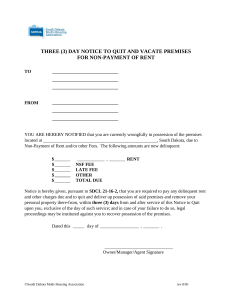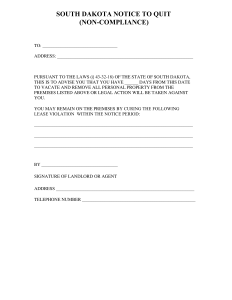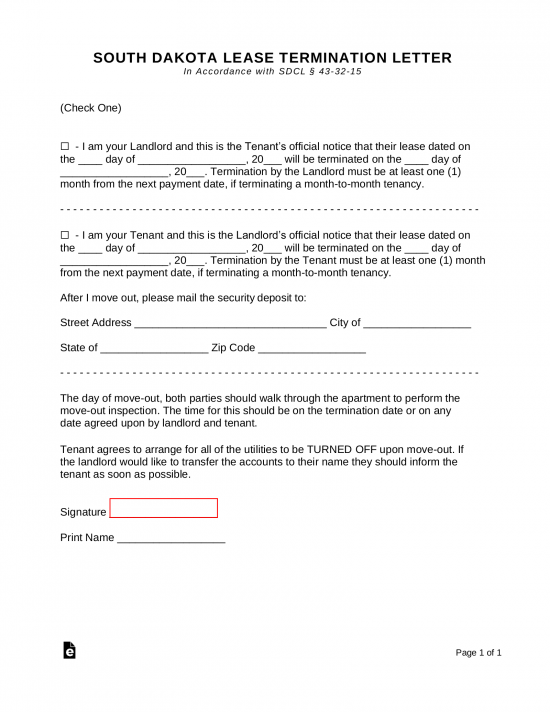Updated April 03, 2024
A South Dakota eviction notice is a document that constitutes the first step a landlord takes to notify a tenant of intent to evict if certain steps are not taken. The landlord writes the notice while including a description of the violation and how many days the tenant has to fix the issue. If the tenant is unresponsive, the landlord can file a forcible entry and detainer lawsuit in the local Magistrate Court or Circuit Court.
By Type (3)
 3-Day Notice to Quit (Non-Payment of Rent) – Tenant has three days after receiving notice from the landlord that they are behind on rental payments to pay or leave the premises before the landlord can go to court to have the tenant evicted. 3-Day Notice to Quit (Non-Payment of Rent) – Tenant has three days after receiving notice from the landlord that they are behind on rental payments to pay or leave the premises before the landlord can go to court to have the tenant evicted.
Download: PDF |
 Notice to Quit (Non-Compliance) – If the tenant has violated the lease, for anything other than non-payment, this notice must be sent, and the tenant must be given “reasonable time” to cure the issue. Notice to Quit (Non-Compliance) – If the tenant has violated the lease, for anything other than non-payment, this notice must be sent, and the tenant must be given “reasonable time” to cure the issue.
Download: PDF |
 30-Day Notice to Quit (Month-to-Month Tenancy) – This form is used by a party to a month-to-month tenancy to let the other party know of his or her intention not to renew. 30-Day Notice to Quit (Month-to-Month Tenancy) – This form is used by a party to a month-to-month tenancy to let the other party know of his or her intention not to renew.
Download: PDF, MS Word, OpenDocument |
Table of Contents |
Prohibited Landlord Actions
Utility Shutoff – If a landlord willfully causes the interruption of electric, gas, water, or other essential services to the tenant, the tenant may sue the landlord, terminate the rental agreement, and recover up to two months’ rent in damages.[5]
Changing the Locks – If a landlord unlawfully removes or excludes the tenant from the premises, the tenant may sue the landlord, terminate the rental agreement, and recover up to two months’ rent in damages.[5]
Court Forms
The following eviction documents must be obtained from the magistrate or circuit court where the rental unit is located; South Dakota does not provide eviction paperwork online.
Summons and Complaint – Landlords can file this document with their local magistrate or circuit court to initiate a forcible entry and detainer action (eviction) against a tenant.
Judgment for Possession – If a landlord wins an eviction lawsuit, the court will issue a Judgment for Possession which proves that the landlord has regained possession of the premises.
Execution for Possession – Landlords may request an Execution for Possession if a tenant continues to reside on the premises after being evicted. This document authorizes the sheriff’s office to visit the tenant and remove them from the property.
How to Evict a Tenant (4 steps)
- Provide Notice to Tenant
- File Court Forms / Serve Tenant
- Receive Court Judgment
- Obtain Execution of Possession If Necessary
2. File Court Forms / Serve Tenant
If the tenant does not respond, the landlord may then go to the Local Magistrate or Circuit Court representing the area in which the property is located to file a Forcible Entry and Detainer Action. The landlord must fill out a Summons and Complaint and have the tenant served.
The filing fee is $70.[6]


